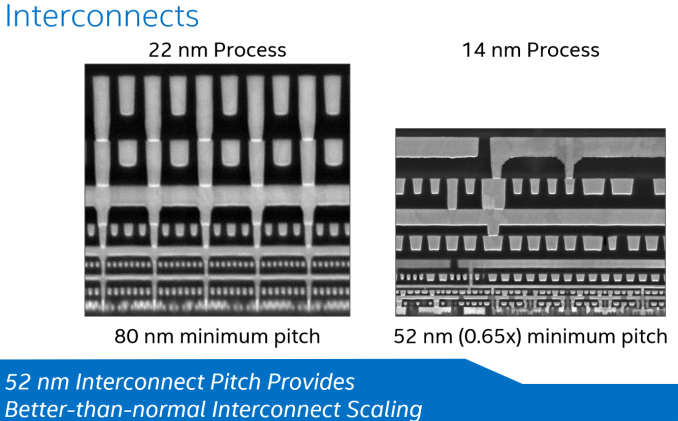ARM Challenging Intel in the Server Market: An Overview
by Johan De Gelas on December 16, 2014 10:00 AM ESTIntel's Future: Xeon-D
Intel's response to all of these competitors is relatively simple. The Atom C2000 might not be strong enough to turn the ARM tide and the Xeon E3 might lose a performance per watt battle here and there due to the extra PCH chip it needs. So take the two and unify the advantages of the Xeon E3 and Atom C2000 in one chip, the Xeon-D. Then use Intel's main industry advantage, the most advanced process technology, in this case the 14nm 2nd generation of trigate transistors.
The Xeon-D should have it all (almost): a Broadwell core that can go as low as 2W per core at 1.2GHz. It can also deliver great single-threaded performance if necessary, as one core can go as high as 2.9GHz! Some people have said that Intel will have a very hard time offering the same richness of integrated hardware blocks as the ARM licensees, but frankly the Xeon-D has almost everything a server application can need: several PCIe 3.0 root complex (24 lanes), 10GbE Ethernet, and PCH logic (6x SATA, USB 3.0/2.0, 8 lanes of PCIe 2.0 and 1GB Ethernet) are all integrated.
Eight of those Broadwell cores will find a place in a 45W SoC. Considering Intel needs 6W to run two cores (and a small integrated GPU) at 1.4GHz, we would not be surprised if the new Xeon-D could reach 1.8GHz or more and that Turbo Boost clocks will be above 3GHz.
The only disadvantage that the SoC has compared to some of the ARM SoCs is the dual-channel memory controller. The Xeon-D will be available in Q3 2015. While roadmaps should always be read with caution, it must be said that Intel rarely delays its products more than a few months. Intel has been executing very well, almost like clock work.











78 Comments
View All Comments
JohanAnandtech - Tuesday, December 16, 2014 - link
Did you miss this page?http://www.anandtech.com/show/8776/arm-challinging...
The software ecosystem is developing...there is no indication that this will stop soon.
Kevin G - Wednesday, December 17, 2014 - link
The LAMP stack is there and can easily give ARM a foot hold. Scaling up they'll need vendors like Oracle to port key applications. ARM will also need to enhance there RAS to be production capable with that software.Samus - Tuesday, December 16, 2014 - link
Johan,You need to review the compatibility of the Xeon E3's. They actually work in just about any Intel 80 or 90-series board. I have an E3-1230v3 in an Asus ITX H87 on the PC I'm currently typing on.
A C220 chipset is NOT required.
JohanAnandtech - Tuesday, December 16, 2014 - link
you are right :-).By "Xeon E3 needs C220" I meant that you need to add that part to calculate the power consumption per node. And the E3 needs it to support ECC RAM.
eanazag - Tuesday, December 16, 2014 - link
Ubuntu's ARM version OS is a big deal. I believe the fact that MS had been dragging on with supporting RT was in fact to have something to port to the server side. Even though RT is mostly a dud at first, it could still be sensible and sell in a server config.I'm waiting for AMD to finally sell the ARM chip in the channel so I can throw a mobo with it together. If it has 10GbE I would be all over it.
rootheday3 - Tuesday, December 16, 2014 - link
Intel also has Rangeley soc which includes crypto block for comms usagewintermute000 - Tuesday, December 16, 2014 - link
"What if I need massive amounts of memory but moderate processing power? The Xeon E3 only supports 32GB."Thousands of techs labbing away @ home nod sagely in agreement. Right now our choices are to scale horizontally or live with loud jet-engine ex-enterprise gear, because I can't get 64gb of RAM into a whitebox.
wintermute000 - Tuesday, December 16, 2014 - link
Clarification: a whitebox that I can afford i.e. not a Xeon E5. lolbeginner99 - Wednesday, December 17, 2014 - link
What kind of servers use tons of RAM and little processing power? Right, memcached and similar stuff. But let's be honest. That is still a niche market given the total server market. Most servers are just standard multipurpose servers running some company internal low-traffic (web) application. They don't need memcached. Memcached is for huge internet deployments and let's be honest that in itself is niche.I work in a 10'000 people company and I would bet you $1000 we have 0 memcached servers. I don't really know except for the lack of performance in core apps and the questionable competency of our IT.
bobbozzo - Wednesday, December 17, 2014 - link
VM servers.And ZFS-filesystem storage (NAS/SAN) servers. e.g. FreeNAS. Add much more RAM if using DeDup.